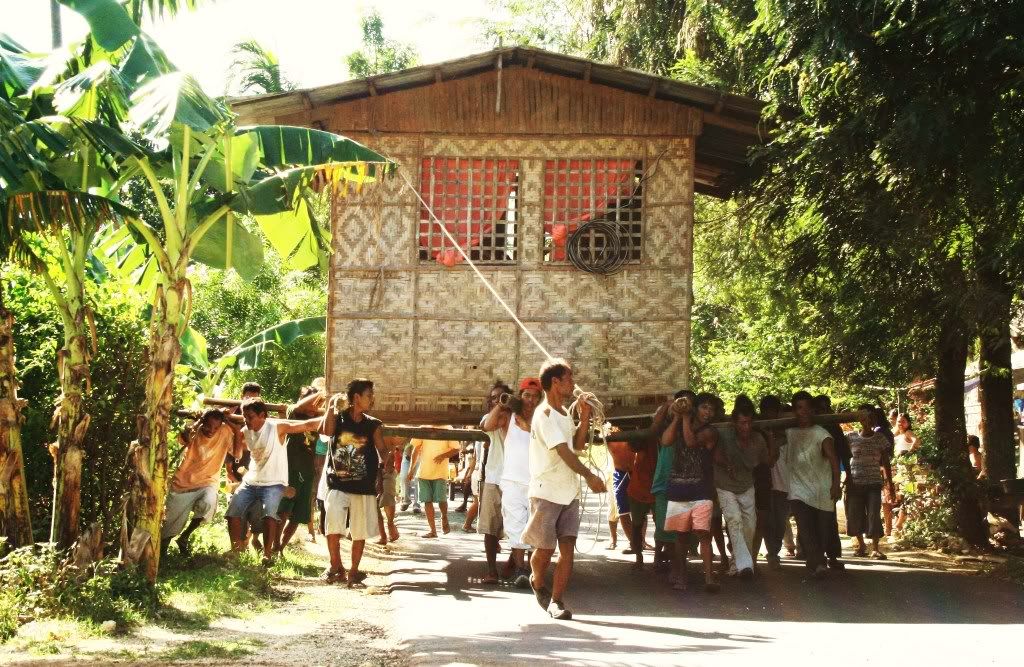For our most recent assignment in English 470A: Canadian Literary Genres, we were asked to read the home stories of three other people in our class (as posted on their blogs) and to make a list of the shared values, assumptions, and stories that we found there. I read the posts of Rajin Sidhu, Sarah Casorso, and Florence Ng, and this is what I noted:
– Home is hard to pin down. It is a broad and individual experience.
– Home is necessary to survival. This becomes observable in new ways in extreme situations (Peterson 196), but it is also true in everyday life.
– Although it often encompasses multiple physical places, a person may associate home primarily with one of them. This is usually the place in which the person “grew up.” As a result, home can move, but it can also be left behind (Glidden 176-78).
– Home does not “do” borders: it crosses them. Migration leads people to new homes, despite governmental policies that sometimes stand in their way.

A Filipino community practicing “bayanihan,” which is the generous act of helping a member move their home to a new location. Photo by Henry de Loyola.
– Community is a huge part of home, and it is usually made up of a person’s friends, family and lovers, as well as, potentially, their neighbours, school companions, and spiritual community.
– Home encompasses and is solidified by varying emotional experiences. These range from the joy of new love to the heartbreak that leads to tears on a pillow at night.
– Cozy, rural locales are often cornerstones of one’s experience of home, but these tend to give way through time and/or distance to the bigger, faster, more developed world.
– Home is strangely impermanent, and can disappear and reappear. This often has to do with changes in one’s emotional life as impacted by their community.
– A person must feel comfortable “being themselves” in order for a sense of home to appear. If there are other people in a person’s home, relational warmth must figure in their connections with each other in order for this to happen. This warmth often manifests in the form of physical affection.
– Home is written all over with stories, including personal history, family history, cultural history, worldview, and spiritual perspective.
– Home is a place where a great deal of learning – of both the intellectual and the experiential kind – takes place. Learning to fail (and, hopefully, learning to succeed) is one of the experiences that is integral to home.
– Last, but not least, home is a place of refuge and safety. (And one wonders how anyone can deny a refugee entry to “their” country, this being the case!)
Overall, it was a revealing experience compiling this list of the things that make up home, because, while I suppose I knew that most of these factors would come up, to have them go from foggy connotations of a daily-used word to concrete elements extrapolated from four different narratives of home was nothing short of illuminating. I think that it developed my sense of compassion for others through showing me a new layer on which every human being is alike.
On that note, can we do family next? 😉
Works Cited
Casorso, Sarah. “2.1: Home Is Where the Heart Is.” Eng470. UBC Blogs, 29 Jan. 2015. Web. 2 Feb. 2015. <https://blogs.ubc.ca/scasorso/2015/01/29/2-1-home-is-where-the-heart-is/>
De Loyola, Henry. Bayanihan1. N.d. Photobucket. Web. 2 Feb. 2015. <http://i242.photobucket.com/albums/ff193/heinzkieh/bayanihan/bayanihan1.jpg>
Glidden, David. “Commonplaces.” Philosophy and Geography III: Philosophies of Place. Ed. Andrew Light and Jonathan M. Smith. Lanham: Rowman & Littlefield, 1998. 169-190. Google Books. Web. 2 Feb. 2015. <http://bit.ly/1AkAOIP>
Ng, Florence. “2.1 Home Is a Pie Chart and a Couple of Memories.” Maple Trees and Beaver Tails. UBC Blogs, 31 Jan. 2015. Web. 2 Feb. 2015. <https://blogs.ubc.ca/florenceng/2015/01/31/45/>
Peterson, Nadya L. “Dirty Women: Cultural Connotations of Cleanliness in Soviet Russia.” Russia–women–culture. Ed. Helena Goscilo and Beth Holmgren. Bloomington: Indiana UP, 1996. 177-208. Google Books. Web. 2 Feb. 2015. <http://bit.ly/1z779MC>
Sidhu, Rajin. “2.1 The Story About My Home(s).” Canada – Home Sweet Home? UBC Blogs, 30 Jan. 2015. Web. 2 Feb. 2015. <https://blogs.ubc.ca/rajinsidhu/2015/01/30/2-1-the-story-about-my-home/>
Hi Lauren – thanks so much for such a thoughtful compilation of what home means to “us.” 🙂
Hi Erika! You’re so welcome! 🙂